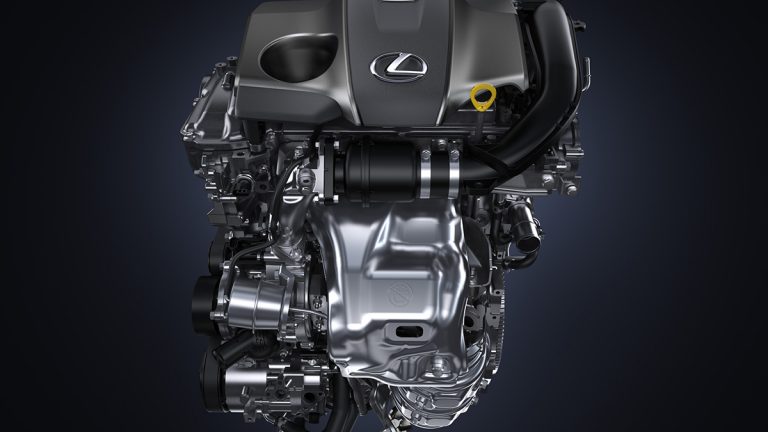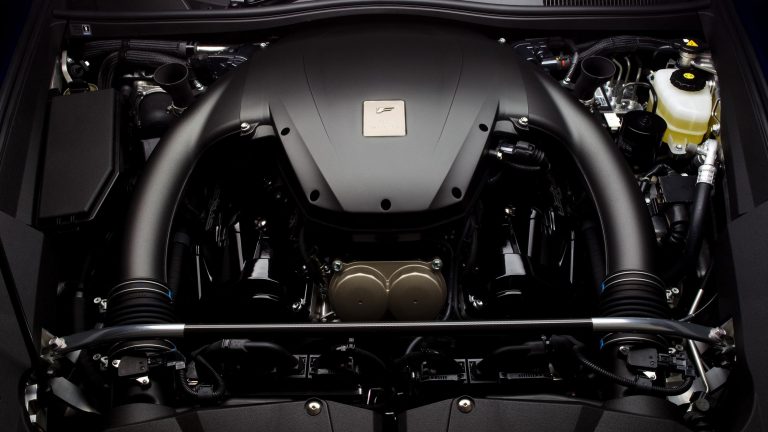[su_image_carousel source=”media: 52260,52261,52262,52263,52264,52265″]
Introduction
The 8AR-FTS was a 2.0-litre four-cylinder petrol engine that had a twin-scroll turbocharger. Developed over a period of nine years, the 8AR-FTS engine was manufactured at Toyota’s Kyushu plant and first deployed in the Lexus NX 200t. According to Lexus, the 8AR-FTS was the first engine to have a cylinder head with an integrated four-into-two exhaust manifold and twin-scroll turbocharger.
Other features of the 8AR-FTS engine included:
- The ability to use a conventional Otto cycle on start-up and then switch to an Atkinson cycle;
- Variable Valve Timing – Intelligent Wide (VVT-iW); and,
- A Stop & Start function which enabled the engine to shut down when the vehicle was stationary to minimise fuel consumption.
The 8AR-FTS engine had a service weight of 160 kg.
[su_table responsive=”yes”]
| Engine | Trans. | Peak power | Peak torque | |
|---|---|---|---|---|
| Lexus NX 200t | 2.0-litre 8AR-FTS turbo petrol I4 | 6sp auto | 175kW at 4800-5600rpm | 350Nm at 1650-4000rpm |
| Lexus AL20 RX 200t | 2.0-litre 8AR-FTS turbo petrol I4 | 6sp auto | 175kW at 4800-5600rpm | 350Nm at 1650-4000rpm |
| Lexus L10.II GS 200t | 2.0-litre 8AR-FTS turbo petrol I4 | 6sp auto | 180kW at 4800-5600rpm | 350Nm at 1650-4000rpm |
| Lexus RC 200t | 2.0-litre 8AR-FTS turbo petrol I4 | 6sp auto | 180kW at 4800-5600rpm | 350Nm at 1650-4000rpm |
| Lexus XE30 IS 200t | 2.0-litre 8AR-FTS turbo petrol I4 | 6sp auto | 180kW at 4800-5600rpm | 350Nm at 1650-4000rpm |
[/su_table]
8AR-FTS block
The 8AR-FTS engine had an open-deck, midi-skirt block that was produced from aluminium alloy. With its 86.0 mm bores and 86.0 mm stroke, the 8AR-FTS engine had a capacity of 1998 cc. It is understood that the 8AR-FTS engine had cast iron liners which were manufactured so that their casting exteriors formed large, irregular surfaces (‘spiny type’) for better adhesion between the liners and the cylinder block.
Balance shafts
The 8AR-FTS engine had twin counter-rotating balance shafts within the crankcase to cancel the secondary inertia forces that were inherent in an in-line four-cylinder engine. Since each piston reached its maximum speed – both rising and falling – at a point just above the centre of the stroke, the upward inertial force of the two rising pistons was greater than the downward inertial force of the two falling pistons. To offset this, the twin gear-driven balance shafts counter-rotated at twice the speed of the crankshaft.
Crankshaft, connecting rods and pistons
The 8AR-FTS engine had a fully balanced forged steel crankshaft which was offset to the thrust side of the cylinder bore centre line to reduce friction. Furthermore, it is understood the 8AR-FTS engine had high-strength steel connecting rods and aluminium alloy pistons. For the latter, cooling jets positioned under the pistons improved durability and enhanced warm-up performance.
Cylinder head and turbocharger
The 8AR-FTS engine had an aluminium alloy cylinder head which, according to Lexus, was first to have an integrated four-into-two exhaust manifold and twin scroll turbocharger.
The exhaust manifold had separate channels for cylinders 1 & 4 and cylinders 2 & 3 which directed air into respective scrolls (hence ‘twin scroll’). The primary advantages of a twin-scroll turbocharger are that:
- A smaller, shaper angled nozzle is used for faster response and a larger, less angled nozzle for top-end performance; and,
- The engine can utilise exhaust scavenging to reduce exhaust gas temperatures and NOx emissions, improve turbine efficiency and reduce turbo lag.
The flow of exhaust gases (‘flow control’) was managed with a variable wastegate on one port to limit boost pressure and a bypass circuit on the other port – this design was adopted to prevent turbine speed from slowing when exhaust gas velocity decreased. Furthermore, the active wastegate minimised pumping losses by reducing back pressure when engine loads were low.
The turbocharger was designed by Lexus and manufactured at its Miyoshi plant. The turbine housing was made from a cast-steel material which had reduced nickel content to resist heat distortion, while the impeller wheel was electron beam welded for accuracy. It is understood that maximum boost pressure for the 8AR-FTS engine was around 1.17 bar (17 psi), while peak turbocharger revolutions were 180,000 rpm.
The 8AR-FTS engine had double overhead camshafts (DOHC) that were driven by a roller chain.
Intercooler and throttle
The 8AR-FTS engine had an air-to-liquid intercooler that was mounted directly to the engine and had its own dedicated coolant supply. Within the intake, the 8AR-FTS engine had an electric air bypass valve and a resonator to reduce turbo noise when the throttle was closed.
It is understood that the 8AR-FTS engine had a link-less type ‘Electronic Throttle Control System – intelligent’ (ETCS-i) which controlled the throttle valve opening according to the amount of accelerator pedal effort and engine condition.
Variable Valve Timing – Intelligent Wide (VVT-iW)
While the exhaust valves for the 8AR-FTS engine had variable timing, the intake valves had a mid-position camshaft lock mechanism which could retard the variable valve timing, known as ‘Variable Valve Timing – Intelligent Wide’ (VVT-iW). The ability to retard intake valve timing enabled the 8AR-FTS engine to:
- Start in the Otto cycle;
- Switch to an Atkinson cycle (i.e. shortened compression stroke and longer expansion stroke) for low-rev operations to minimise fuel consumption; and,
- Use an Otto cycle at higher engine speeds for greater power.
Otto and Atkinson cycles
In a conventional (Otto) cycle engine, compression stroke volume and expansion stroke volume are practically identical, such that the compression ratio and expansion ratio are also identical. Hence, any attempt to increase the expansion ratio also increases the compression ratio, and hence the likelihood of engine knock or pre-ignition. Please note that:
- Expansion ratio = (expansion stroke volume + combustion chamber volume)/combustion chamber volume; and,
- Compression ratio = (compression stroke volume + combustion chamber volume)/combustion chamber volume.
Lexus described the 8AR-FTS engine as having an ‘Atkinson cycle’ since the compression stroke was shortened and the expansion stroke extended. This was achieved by keeping the intake valves open during the initial stage of the compression stroke (when the piston was ascending) to allow a reverse flow of intake air into the intake manifold – this allowed for an increase in throttle valve opening in part load conditions, thereby reducing intake manifold vacuum and pumping losses. Furthermore, closure of the intake valves was delayed until the end of the expansion stroke, thereby increasing the expansion ratio.
Since this ‘Atkinson’ operation used a smaller portion of the compression stroke to compress the intake air, it did not take in as much air as a comparable Otto cycle engine and had lower power density, yet higher thermal efficiency.
Lexus quoted the 8AR-FTS engine as having a compression ratio of 10.0:1.
ESTEC D-4ST
The 8AR-FTS engine had Lexus’ ESTEC D-4ST (Economy with Superior Thermal Efficient Combustion Direct injection 4-stroke with Turbo) fuel injection. With separate twin injectors for both direct and port injection, ESTEC D-4ST could perform high-pressure direct injection into the cylinder and conventional intake port injection, or direct cylinder injection only, according to engine speed. Hence, intake air and fuel were mixed evenly at all engine speed ranges, increasing throttle response, power and torque over a wide range of engine speeds without sacrificing fuel efficiency and environmental performance.
The 8AR-FTS engine had a ‘Stop & Start’ function that enabled the engine to shut down while the vehicle was stationary in traffic to reduce fuel consumption. The ESTEC D-4ST system could inject fuel into one cylinder while it was stopped on its compression stroke, allowing ignition and combustion to occur simultaneously to quickly re-start the engine. As a result, the Stop & Start system for the 8AR-FTS delayed start-up until the accelerator pedal was activated, in contrast to many systems which start the engine when the brake pedal is released.



